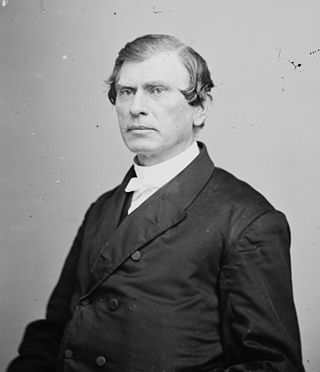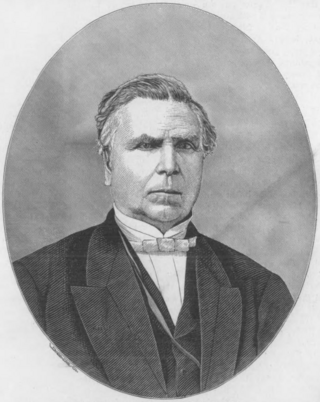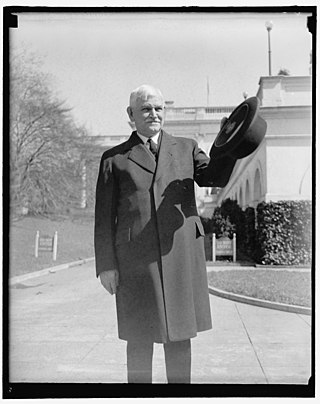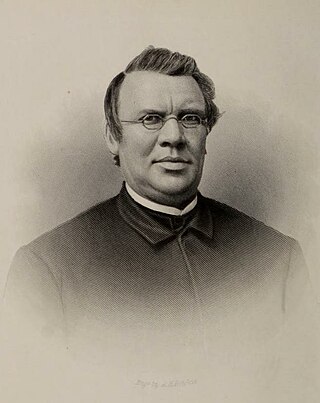The Methodist Episcopal Church (MEC) was the oldest and largest Methodist denomination in the United States from its founding in 1784 until 1939. It was also the first religious denomination in the US to organize itself nationally. In 1939, the MEC reunited with two breakaway Methodist denominations to form the Methodist Church. In 1968, the Methodist Church merged with the Evangelical United Brethren Church to form the United Methodist Church.
The Methodist Episcopal Church, South was the American Methodist denomination resulting from the 19th-century split over the issue of slavery in the Methodist Episcopal Church (MEC). Disagreement on this issue had been increasing in strength for decades between churches of the Northern and Southern United States; in 1845 it resulted in a schism at the General Conference of the MEC held in Louisville, Kentucky.

Matthew Simpson was an American bishop of the Methodist Episcopal Church, elected in 1852 and based mainly in Philadelphia. During the Reconstruction Era after the Civil War, most evangelical denominations in the North, especially the Methodists, were initially strong supporters of radical policies that favored the Freedmen and distrusted the Southern whites. However, by the late 1860s in border state conferences, the MEC North moved well away from their work with the Freedmen's Bureau and often sided with the grievances of Southern white members. Bishop Simpson played a leading role in mobilizing the Northern Methodists for the cause. His biographer calls him the "High Priest of the Radical Republicans."

John Miley was an American Methodist Episcopal minister and theologian, who was one of the major Methodist theological voices of the 19th century.

William McKendree was an Evangelist and the fourth Bishop of the Methodist Episcopal Church, and the first Methodist bishop born in the United States. He was elected in 1808.

Franklin Elmer Ellsworth Hamilton was an American bishop of the Methodist Episcopal Church, elected in 1916.

Thomas Asbury Morris was an American bishop of the Methodist Episcopal Church, elected in 1836. He also distinguished himself as a Methodist circuit rider, pastor, and presiding elder, and as an editor.

Edward Raymond Ames was an American Bishop of the Methodist Episcopal Church, elected in 1852.

John Morgan Walden was an American bishop of the Methodist Episcopal Church. He also gained notability as a newspaper editor and journalist, as a State Superintendent of Education in Kansas, as an officer in the Union Army, and as an Official in his Christian denomination.

Edwin Holt Hughes was an American bishop of the Methodist Episcopal Church, elected in 1908.

William Alfred Quayle was an American Bishop of the Methodist Episcopal Church, elected in 1908.

Rev. William Fraser McDowell, A.B., S.T.B., was an American bishop of the Methodist Episcopal Church.

John Christian Keener was an American bishop of the Methodist Episcopal Church, South, an author and an editor, and the superintendent of C.S.A. chaplains west of the Mississippi River during the American Civil War. He wrote several books on theology and edited the New Orleans Christian Advocate, a weekly Methodist newspaper sponsored by Methodist conferences in Louisiana and various nearby states in the late-19th and early-20th century. A collection of Keener's papers, available at the Stuart A. Rose Manuscript, Archives, and Rare Book Library at Emory University, include correspondence and military orders related to the return of property to the Methodist Church, South, after the war.
Jashwant Rao Chitambar was the first Indian bishop of the Methodist Episcopal Church of North and South India, elected in 1930.
John Louis Nuelsen was a German-American Bishop of the Methodist Episcopal Church and The Methodist Church, elected in 1908. He also distinguished himself as a Methodist pastor, as a college and seminary professor and theologian, and as an author and editor.
An episcopal area in the United Methodist Church (UMC) is a basic unit of this denomination. It is a region presided over by a resident bishop that is similar to a diocese in other Christian denominations. Each annual conference in the UMC is within a single episcopal area; some episcopal areas include more than one annual conference. Episcopal areas are found in the United States as well as internationally. In some cases, such as the Western Jurisdiction of the US as well as some places internationally, an episcopal area covers a very large territory.

John Early was instrumental in organizing the Methodist Episcopal Church, South, and was their bishop from 1854.
The ordination of women has been commonly practiced in Methodist denominations since the 20th century, and some denominations earlier allowed women to preach.

The history of Methodism in the United States dates back to the mid-18th century with the ministries of early Methodist preachers such as Laurence Coughlan and Robert Strawbridge. Following the American Revolution most of the Anglican clergy who had been in America came back to England. John Wesley, the founder of Methodism, sent Thomas Coke to America where he and Francis Asbury founded the Methodist Episcopal Church, which was to later establish itself as the largest denomination in America during the 19th century.

John Swanel Inskip was an American minister and evangelist affiliated with the Methodist Episcopal Church. He was a proponent of family sittings in church and a leader in the holiness movement, serving as founder and president of the National Camp Meeting Association for the Promotion of Holiness from 1867 until his death.















